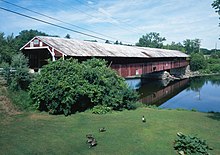Haverhill–Bath Covered Bridge
Haverhill-Bath Covered Bridge | |
 The bridge following restoration in 2004 | |
| Location | Next to NH 135, Woodsville, New Hampshire |
|---|---|
| Coordinates | 44°9′16″N 72°2′12″W / 44.15444°N 72.03667°W |
| Area | 0.1 acres (0.040 ha) |
| Built | 1829 |
| Architectural style | Town lattice truss |
| NRHP reference No. | 77000091[1] |
| Added to NRHP | April 18, 1977 |
The Haverhill-Bath Covered Bridge is a historic covered bridge over the Ammonoosuc River joining Bath and Woodsville, New Hampshire. Formerly used to carry New Hampshire Route 135, the bridge was idled in 1999. Restored in 2004, it is now open to foot traffic only. It is believed to be the oldest covered bridge in the state.[2]

The bridge was built in 1829 with funding provided by both towns. It was built by Moses Abbott and Leonard Walker after Airel Miner, the first choice to supervise the construction, stepped down. The bridge is a Town lattice truss bridge with two spans. The road bed is 256'8" long and 14'4" wide and the roof is 277'8" long, covering not just the bridge but also framed entrances on both sides. There is a sidewalk (not part of the original construction) on the east side of the bridge that is 6'1" wide. The roof on that side is extended over the sidewalk, giving the roof profile that of a saltbox house.[2]
The bridge has survived a number of flooding events, most notably in 1927, when the lattice work was pierced by a tree trunk, and a barn was carried into the structure. It has been renovated multiple times, most recently in 2004. The bridge was listed on the National Register of Historic Places in 1977.[1]
See also
References
- ^ a b "National Register Information System". National Register of Historic Places. National Park Service. March 13, 2009.
- ^ a b "NRHP nomination for Haverhill-Bath Covered Bridge". National Park Service. Retrieved 2014-04-01.
See also
- List of New Hampshire covered bridges
- List of bridges on the National Register of Historic Places in New Hampshire
- National Register of Historic Places listings in Grafton County, New Hampshire
- Covered bridges in New Hampshire
- Covered bridges on the National Register of Historic Places in New Hampshire
- Bridges completed in 1829
- Bridges in Grafton County, New Hampshire
- Visitor attractions in Grafton County, New Hampshire
- Road bridges in New Hampshire
- National Register of Historic Places in Grafton County, New Hampshire
- Haverhill, New Hampshire
- Road bridges on the National Register of Historic Places in New Hampshire
- New Hampshire Registered Historic Place stubs
- Northeastern United States bridge (structure) stubs
- New Hampshire building and structure stubs
- New Hampshire transportation stubs



